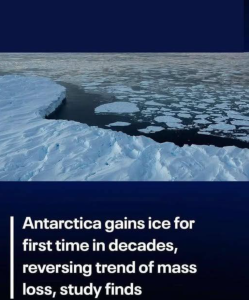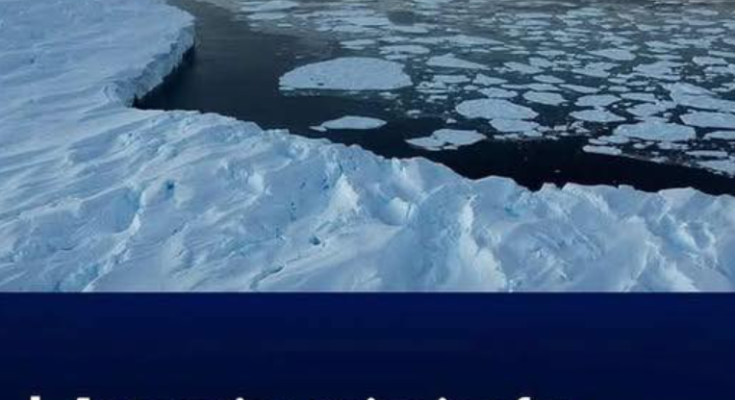Antarctica Sees First Ice Gain in Decades
For the first time in decades, Antarctica—the frozen continent infamous for its swelling ice losses—has recorded a net gain in ice mass. Between 2021 and 2023, the Antarctic Ice Sheet (AIS) gained approximately 108 gigatonnes (Gt) of ice annually—a marked reversal from the rapid losses of the previous decade. This gain temporarily offset global sea-level rise by around 0.3 millimeters per year
Where Did This Gain Come From?
Scientists pinpoint anomalously heavy snowfall—particularly concentrated in parts of East Antarctica—as the primary driver behind this unexpected increase. Regions such as Wilkes Land, Queen Mary Land, Totten, Denman, Moscow University, and Vincennes Bay glaciers all contributed substantially to the gain after years of accelerating decline
A Temporary Anomaly—Not a Long-Term Reversal
Experts are quick to warn: this is a short-lived anomaly, not evidence of a long-term recovery. The broader trend remains one of persistent decline. Since at least the early 2000s, Antarctica has been shedding ice at an average rate of roughly 140–150 Gt per year—a significant driver of global sea-level rise
This year’s gain stems from short-term weather patterns, not a shift in climate direction. As one researcher noted, warmer air holds more moisture—so increased snowfall in a warming world isn’t unusual. But ocean-driven melting and ice discharge continue apace under the surface, especially in West Antarctica
Not Rewriting the Climate Narrative
The brief ice resurgence has been misappropriated by climate skeptics as proof that global warming is overblown. But scientists are clear: one uptick doesn’t negate two decades of steady ice loss. The AFP fact-check stresses that while snowfall caused temporary mass gains, ocean-driven ice sheet instability remains the biggest threat
Three Phases of Recent Antarctic Ice Change
Research breaks down Antarctic ice behavior into three distinct periods:
-
2002–2010: Moderate loss (~–74 Gt/yr), contributing ~0.2 mm/yr to sea-level rise.
-
2011–2020: Accelerated loss (~–142 Gt/yr), contributing ~0.39 mm/yr.
-
2021–2023: Notable gain (~+108 Gt/yr), offsetting ~0.3 mm/yr of rise.
This shift may reduce Antarctica’s sea-level contribution in the short term, but the long-term sea-level rise trend remains intact.
Persistent Threats—West Antarctica’s Hidden Danger
Despite the gain, West Antarctica remains perilous. Its coastal glaciers continue melting rapidly from warmer oceans, a trend backed by both observational data and predictive modeling. Without sustained intervention, this could lead to multi-meter sea-level rise over the coming centuries. A recent study warns that if current ocean warming persists, destabilization of Thwaites and Pine Island glaciers could add up to 3 mm per year to global sea levels over centuries
Complex Climate Systems and Lessons Learned
Antarctica’s surprise rebound reminds us that the climate system is non-linear and deeply complex. Weather anomalies like record snowfall can obscure strong trends like melting ice shelves and glacier flow acceleration.
Key takeaways:
-
Short-term data shouldn’t override long-term trends.
-
Antarctica’s behavior is influenced by both atmospheric and oceanic dynamics.
-
Climate models must integrate these nuances to improve accuracy.
What This Means for Policy and Awareness
While momentarily easing pressure on predictions, the gain should be seen not as a reprieve—but as a wake-up call. It highlights the need for:
-
Continued emissions reductions
-
Rigorous climate modeling that captures variability
-
Sustained attention to long-term sea-level projections
In short, the global climate crisis is far from over, even if Antarctica took a brief breath.
Summary in Brief
| Period | Antarctic Ice Trend | Impact on Sea Level |
|---|---|---|
| 2002–2010 | Moderate ice loss (~–74 Gt/yr) | +0.2 mm/year |
| 2011–2020 | Accelerated loss (~–142 Gt/yr) | +0.39 mm/year |
| 2021–2023 | Temporary gain (~+108 Gt/yr) | –0.3 mm/year (offset) |
-
The 2021–2023 gain resulted from unusually heavy snowfall.
-
Specialists caution this does not reverse long-standing ice loss trends.
-
Core concerns—especially glacier instability in West Antarctica—remain unchanged.
Antarctica Sees First Ice Gain in Decades
For the first time in decades, Antarctica—the frozen continent infamous for its swelling ice losses—has recorded a net gain in ice mass. Between 2021 and 2023, the Antarctic Ice Sheet (AIS) gained approximately 108 gigatonnes (Gt) of ice annually—a marked reversal from the rapid losses of the previous decade. This gain temporarily offset global sea-level rise by around 0.3 millimeters per year
Where Did This Gain Come From?
Scientists pinpoint anomalously heavy snowfall—particularly concentrated in parts of East Antarctica—as the primary driver behind this unexpected increase. Regions such as Wilkes Land, Queen Mary Land, Totten, Denman, Moscow University, and Vincennes Bay glaciers all contributed substantially to the gain after years of accelerating decline
A Temporary Anomaly—Not a Long-Term Reversal
Experts are quick to warn: this is a short-lived anomaly, not evidence of a long-term recovery. The broader trend remains one of persistent decline. Since at least the early 2000s, Antarctica has been shedding ice at an average rate of roughly 140–150 Gt per year—a significant driver of global sea-level rise.
This year’s gain stems from short-term weather patterns, not a shift in climate direction. As one researcher noted, warmer air holds more moisture—so increased snowfall in a warming world isn’t unusual. But ocean-driven melting and ice discharge continue apace under the surface, especially in West Antarctica.
Not Rewriting the Climate Narrative
The brief ice resurgence has been misappropriated by climate skeptics as proof that global warming is overblown. But scientists are clear: one uptick doesn’t negate two decades of steady ice loss. The AFP fact-check stresses that while snowfall caused temporary mass gains, ocean-driven ice sheet instability remains the biggest threat
Three Phases of Recent Antarctic Ice Change
Research breaks down Antarctic ice behavior into three distinct periods:
-
2002–2010: Moderate loss (~–74 Gt/yr), contributing ~0.2 mm/yr to sea-level rise.
-
2011–2020: Accelerated loss (~–142 Gt/yr), contributing ~0.39 mm/yr.
-
2021–2023: Notable gain (~+108 Gt/yr), offsetting ~0.3 mm/yr of rise.
This shift may reduce Antarctica’s sea-level contribution in the short term, but the long-term sea-level rise trend remains intact.
Persistent Threats—West Antarctica’s Hidden Danger
Despite the gain, West Antarctica remains perilous. Its coastal glaciers continue melting rapidly from warmer oceans, a trend backed by both observational data and predictive modeling. Without sustained intervention, this could lead to multi-meter sea-level rise over the coming centuries. A recent study warns that if current ocean warming persists, destabilization of Thwaites and Pine Island glaciers could add up to 3 mm per year to global sea levels over centuries
Complex Climate Systems and Lessons Learned
Antarctica’s surprise rebound reminds us that the climate system is non-linear and deeply complex. Weather anomalies like record snowfall can obscure strong trends like melting ice shelves and glacier flow acceleration.
Key takeaways:
-
Short-term data shouldn’t override long-term trends.
-
Antarctica’s behavior is influenced by both atmospheric and oceanic dynamics.
-
Climate models must integrate these nuances to improve accuracy.
What This Means for Policy and Awareness
While momentarily easing pressure on predictions, the gain should be seen not as a reprieve—but as a wake-up call. It highlights the need for:
-
Continued emissions reductions
-
Rigorous climate modeling that captures variability
-
Sustained attention to long-term sea-level projections
In short, the global climate crisis is far from over, even if Antarctica took a brief breath.
Summary in Brief
Period Antarctic Ice Trend Impact on Sea Level 2002–2010 Moderate ice loss (~–74 Gt/yr) +0.2 mm/year 2011–2020 Accelerated loss (~–142 Gt/yr) +0.39 mm/year 2021–2023 Temporary gain (~+108 Gt/yr) –0.3 mm/year (offset) -
The 2021–2023 gain resulted from unusually heavy snowfall.
-
Specialists caution this does not reverse long-standing ice loss trends.
-
Core concerns—especially glacier instability in West Antarctica—remain unchanged.
-


